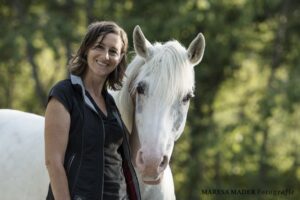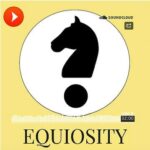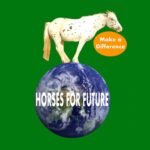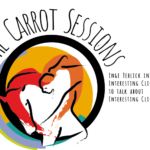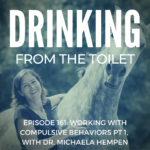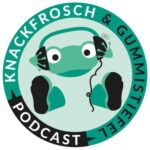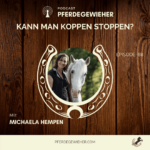Hey, it’s Michaela.
So glad you’ve stopped by to read this page.
Are you already clicker training?
Not yet? Well, you should!
Or maybe you just started, you like it (who doesn’t) and now you are looking for some more information?
That’s awesome!
I know your horse will appreciate your explorations and I hope I can give you some answers to questions you may have.
Just like you, I started with a Google search on ‘clicker+horse’ and landed on Alexandra Kurland’s website. If you have not yet seen her website and Blog, you should pause reading this and read some of her many excellent articles on clicker training.
I wait for you…
Welcome back!
A treasure trove, right?
I started out by reading her articles and books and watching her DVDs.
Since 2013, I am one of Alexandra Kurland’s coaches of her online course which I have translated to German and published in 2016.
I have organized a number of workshops with Alexandra in Germany and Italy, many of them in combination with attending Anja Beran’s International Workshop.
In 2019, I hosted the first Clicker Training and Behaviour Science Summer Camp with Alexandra Kurland, Jesús Rosales-Ruiz, and Mary Hunter, and in 2020 and 2021, I presented together with them during the online science camps (pandemic, remember?)
In 2021, Alexandra invited me to co-teach some of her Stay-At-Home Clinics and in 2022, I co-presented with her at Clicker Expo Live.
Later that year, we organised a virtual Dressage Camp with Anja Beran as a special guest. That was a treat! A weekend deep dive into horses, balance and Feldenkrais lessons given by Anita Schnee.
It’s fair to say that I gained some experience training horses and coaching people with horses.
My work with horses is based on 4 PILLARS that inform each other:
- Clicker training
- Classical dressage
- Feldenkrais method
- Science
Further down I provide interesting details on these 4 pillars and links to other sources that you may want to investigate.
In addition, I suggest the following podcasts to which I was invited: Equiosity (episodes 27, 28, 83, 167-169, 190, 191), Horses for Future (episodes 6,7), Friends on Horses, and The Carrot Sessions Webinar and Drinking from the Toilet (episodes 161, 162).
And the podcasts in German:
Knackfrosch & Gummistiefel, Pferdegewieher (episodes 88, 108) and Fair.Stärkt (episodes #02-05, #02-08, #03-05)
[bleed style=”steel”]
My Goal
My goal is to help people build a wonderful RELATIONSHIP with their horses based on kindness and considering emotional as well as physical BALANCE.
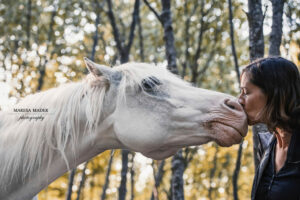 The method I am applying is clicker training on the foundation of an ethic that respects the wellbeing of the horses and their person.
The method I am applying is clicker training on the foundation of an ethic that respects the wellbeing of the horses and their person.
I am driven by the curiosity of a scientist in exploring questions that are both theoretical and practical.
With a similar curiosity, kindness, and without judgment, I aim at finding balance, elegance, and ease of movement in horses and humans.
[/bleed]
My mentors

In 2010, I began learning about CLICKER TRAINING from Alexandra Kurland. The positive effects on my horse and our relationship were immediate and from that moment, I was hooked and studied her work intensely.
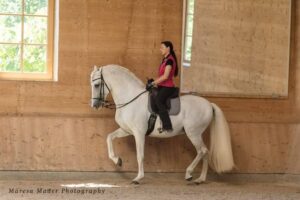
Anja Beran influences my work with horses greatly. I admire her outstanding skills as a rider and teacher but also her kind, generous and passionate personality. Her therapeutic riding proves the importance of CLASSICAL DRESSAGE and why we should learn more about achieving balance even if we never imagine ourselves training a piaffe.
But that’s not the whole picture.
There are a few more mentors who influence my training approach:

Jesús Rosales-Ruiz, Professor of APPLIED BEHAVIOR ANALYSIS at the University of North Texas, who also supervised my MSc thesis, and Mary Hunter, a behavior analyst, animal trainer, and a real expert in explaining complex scientific principles to people who are not behavior analysts, such as myself.
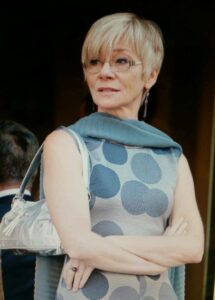
Nathalie Van Cauwenberghe is my instructor in the FELDENKRAIS METHOD. She has a background in classical dance and rhythmic gymnastics at the Olympic level and is passionate about graceful movement in balance. She has helped me immensely to improve my body awareness and made my communication with my horses more efficient and fluent.
Now that you have met my mentors, let me describe in more detail how each of them influences my work with the horses.
But first I want you to meet Asfaloth.
[bleed style=”turquoise”]
Asfaloth – my own beautiful challenge
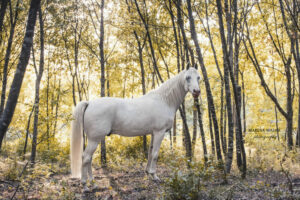
Asfaloth came to me in January 2009. A 10-year old Arabian-Cross gelding, trained as a reining horse. He was beautiful, attentive, and also very angry.
He did not stand still being tied, threatened to bite when reaching for the halter and during saddling.
Riding was not without challenges. He would often escape into uncontrolled backing, sometimes rear, and was an expert in ridding himself of the rider by performing a sudden spin. It was all manageable but not so much fun.
How could I change that?
[/bleed]
Finding Clicker Training
I always had a passion for DRESSAGE. I love the harmony between horse and rider, this magical connection that creates a communication invisible to the outside. But I didn’t know how I could achieve that.
So I started taking lessons with a Classical Dressage instructor in my area.
Then, during a lesson on a cold winter evening, SOMETHING HAPPENED that changed my whole approach to horse training, and life in general.
It was one of those cold days with snow sliding off the roof that turns horses into time bombs ready to explode at any moment.
Asfaloth was explosive that evening and my instructor told me to make him trot faster around the arena in the hope he would focus more on the work. That was a stupid idea (I recognized that later). He could not cope and started bucking. On the third buck, I hang on his neck. He was good and came to a halt but I could not get back into the saddle and had to let go, falling with my shoulder first on the frozen ground.
The result was a broken scapula which meant I could not ride for a month.
In hindsight, this was a good thing because I started implementing what I had already learned from Alexandra’s THE-CLICK-THAT-TEACHES Series.
From the first targeting lesson, I was amazed at how smart my horse was (of course!) and how much fun we had. I was hooked.
Others began noticing the changes. The barn owner told me how playful Asfaloth had become and my vet noticed that he was a lot friendlier and cooperative.
Classical Dressage
I put my dressage ambition on hold for a while focussing on learning clicker training.
But I kept my goal of reaching the harmony that I admire so much in great riders. It was in 2011, that I discovered my road towards achieving that goal when I met Anja Beran, attending her first annual International Workshop.
What inspired me then was her skill to use dressage therapeutically. She presented a number of horses, that were destined to be pasture buddies at best. Yet these horses were showing us exquisite piaffe, flying changes, and much more.
Anja explained how she achieves this transformation by applying the principles of classical dressage with lots of patience, love, and skill. At that moment, I knew that I wanted to learn as much as I could from Anja.
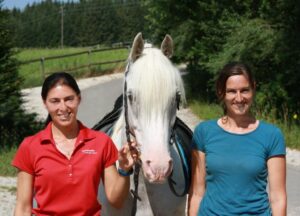
In 2012, I gathered all my courage and traveled with Asfaloth across the Alps to spend one month with Anja. What I learned during that time has directed Asfaloth’s training until today.
Anja gave me the guiding principles that help him align his body in a better balance. My job was to find a way to teach him.
This is how it all connects to CLICKER TRAINING.
A-Squared
But HOW do these puzzle pieces fit together?
At first, the connections between classical dressage and Alexandra’s clicker training were not obvious. Alexandra does not have a lesson called ‘shoulder-in’ and for good reason. But BALANCE is embedded in her work and it leads directly to the lessons we know from classical dressage.
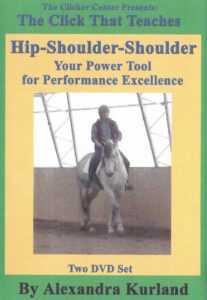
The connection became apparent to me when I was working on a lesson called “Hip-Shoulder-Shoulder” (DVD Lesson 17 of The-Click-That-Teaches series). It was the revelation of connecting to the outside rein into the contact that finally made sense to me and connected the work of Alexandra Kurland with what I learned from Anja Beran.
Don’t think that you can just skip lessons 1-16 and get the same effect! You need the preparatory steps! Trust me on this.
From that moment, I began seeing CONNECTIONS everywhere.
That’s what I call A-squared:
Anja teaches me WHAT I need to train and Alex teaches me HOW to train it.
Anja’s horses move with such elegance and grace. Light as a feather. It is a delight to watch. If you have not seen her ride, you should visit her website and follow her Facebook fan page. She also has excellent books and DVDs. (If you can get only one, then you should watch this one).
You should also listen to Equiosity episodes 74, 75 & 76 when Alexandra, myself, and a wonderful group of clicker trainers met with Anja for a private chat.
Alexandra’s foundation lessons lead to improved balance and movement for the horse’s benefit and continue developing with the more advanced lessons. It’s all intertwined.
In addition, Alexandra is teaching us, the rider, to move in a better balance. Our horses tell us how important that is.
And here’s the connection to the FELDENKRAIS METHOD.
Feldenkrais method
Moshe Feldenkrais was an outstanding person. Read his biography, it’s very interesting. You can read a concise biography here.
The method he developed, initially to manage his injured knee, is quite different from physiotherapy or physical exercises such as Pilates or Yoga.
The Feldenkrais Guild® of North America describes the method as such
The Feldenkrais Method® of somatic education is a powerful and revolutionary approach to improving your life that uses gentle, mindful movement to bring new awareness and possibility into every aspect of your life.
If you want to know how this relates to horse training and clicker training, in particular, you should listen to Equiosity podcast episodes 144 and 145 with Feldenkrais practitioner Anita Schnee, who knows Alexandra’s work in detail and guides lessons during Alexandra’s clinics.
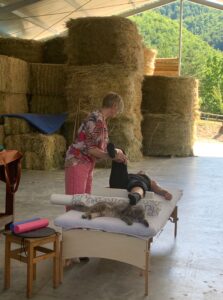
I take weekly Feldenkrais lessons and my horses tell me that it’s time well spent.
My communication with them is much clearer and overall, I feel a lot better. My chronic back pain disappeared and my knee stopped hurting.
And that carries over to my riding.
Find a practitioner in your area and give it a try.
Science
I am a scientist and that makes me a skeptic per definition.
Before investing myself in a new endeavor, I do my research and study the evidence.
What convinced me about clicker training was the scientific basis. In fact, there is a whole field of science behind it: APPLIED BEHAVIOR ANALYSIS or short ABA.
Who knew? (In my defense, it’s not well known in Europe.)
By the way, I was equally hesitant about the Feldenkrais method but there is convincing evidence that it is effective. So I tried it.
Now this field of ABA turned out to be REALLY interesting. It’s actually closer to Biology (my field as a trained veterinarian) than Psychology.
I began reading textbooks and scientific articles. A very good entry into this field is through Dr. Susan Friedman’s Living and Learning with Animals course.

I wanted to bring ABA to the veterinary sciences.
So I convinced Jesús Rosales-Ruiz to be my supervisor for a MSc thesis in Equine Science on stereotypic behaviors. To my surprise, the University of Edinburgh accepted my proposal.
This started a whole new exploration that I will describe somewhere else.
Just to say that this journey, gave me a new understanding of behavior and training – and a new horse.
We’ll get to that.
For now, let me leave you with all that.
Explore the resources that I provided and then come back to this website, if you like, and investigate some more.
Have FUN doing it.
Yours,
Michaela
(Dr. med. vet. Michaela Hempen MSc)
